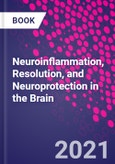Neuroinflammation, Resolution, and Neuroprotection in the Brain discusses the molecular aspects of neuroinflammation in neurological disorders. The book examines the effect of diet and exercise on neuroinflammatory diseases. Chapters focus on bioactive lipids, cytokines and chemokines, as well as the involvement of neuroinflammation, resolution and neuroprotection in neurotraumatic diseases, neurodegenerative diseases and neuropsychiatric diseases. The comprehensive information in this monograph will help readers understand molecular cross-talk among mediators of phospholipid, sphingolipid and cholesterol metabolism. The book's goal is to jumpstart more studies on molecular mechanisms and the therapeutic aspects of neurological disorders in human subjects.
Please Note: This is an On Demand product, delivery may take up to 11 working days after payment has been received.
Table of Contents
1. Molecular aspects of neuroinflammation: Contribution of eicosanoids, cytokines and chemokines
2. Contribution of bioactive lipids mediators in neuroinflammation, resolution, and neuroprotection
3. Contribution of protein-derived bioactive molecules (cytokines and chemokines) in neuroinflammation, resolution, and neuroprotection
4. Contribution of neuroinflammation, resolution, and neuroprotection in neurotraumatic diseases
5. Contribution of neuroinflammation, resolution, and neuroprotection in neurodegenerative diseases
6. Contribution of neuroinflammation, resolution, and in neuropsychiatric diseases
7. Regulation of neuroinflammation, resolution, and neuroprotection by diet and gut microbiota
8. Regulation of neuroinflammation, resolution, and neuroprotection by aerobic exercise, yoga, and tai-chi
9. Prevention of neuroinflammation and resolution by phytochemicals
10. Effects of dietary patterns, exercise on neuroinflammation: Perspective and future studies








